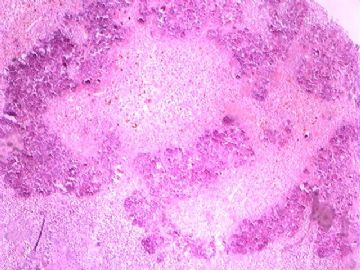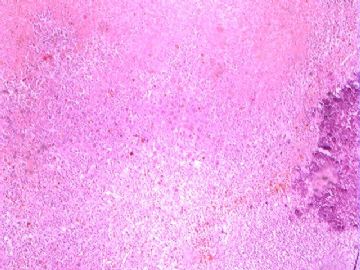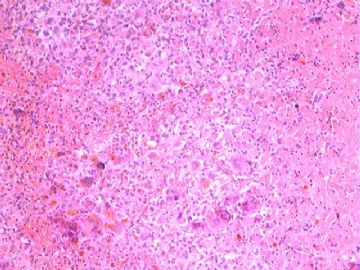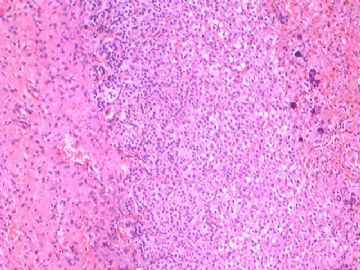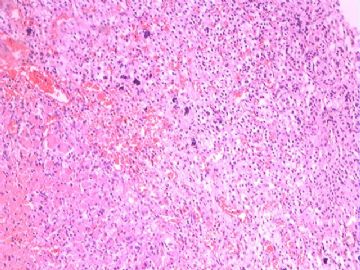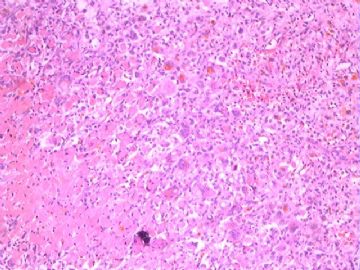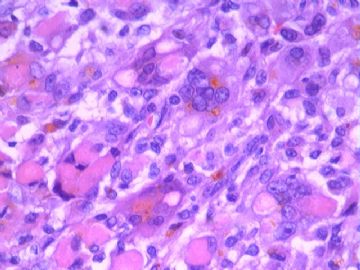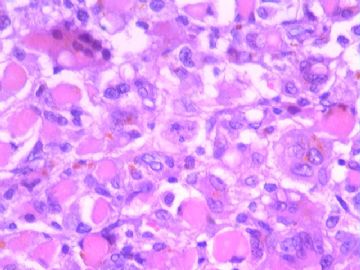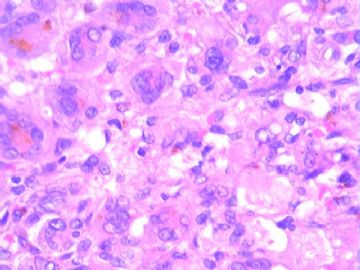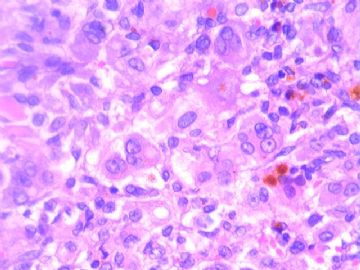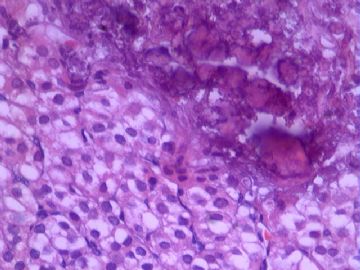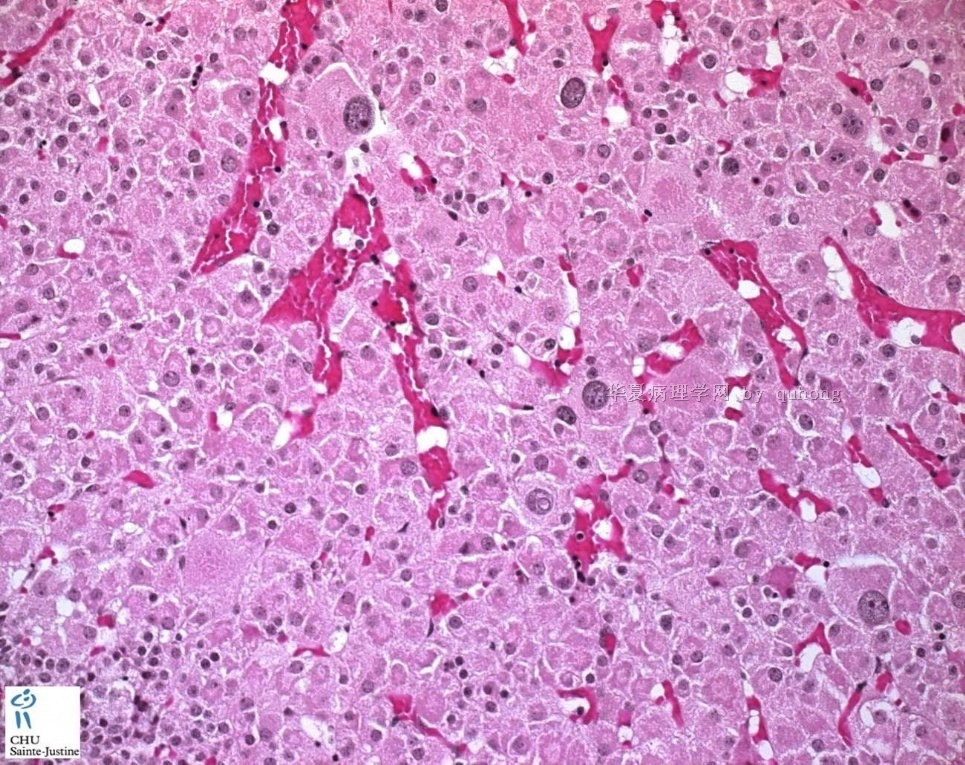| 图片: | |
|---|---|
| 名称: | |
| 描述: | |
- 右肾上腺肿块 帮忙会诊!(十分罕见,多发表意见呀!)
-
chengs2001 离线
- 帖子:76
- 粉蓝豆:12
- 经验:87
- 注册时间:2006-09-27
- 加关注 | 发消息
-
lantian0508 离线
- 帖子:1250
- 粉蓝豆:42
- 经验:1495
- 注册时间:2007-08-01
- 加关注 | 发消息
-
xiaojingling 离线
- 帖子:53
- 粉蓝豆:1
- 经验:53
- 注册时间:2009-04-18
- 加关注 | 发消息
-
vitamin-xbl 离线
- 帖子:383
- 粉蓝豆:0
- 经验:431
- 注册时间:2007-04-03
- 加关注 | 发消息
| 以下是引用liguoxia71在2009-9-14 11:26:00的发言: 肾上腺巨细胞症(anrenal cytomegaly)是一种非常罕见的先天性疾病,国内报道较少。大多数于胎儿或新生儿尸检中发现。患儿往往大体表现正常,组织学显著特征是胎性皮质细胞在细胞大小、形状及细胞结构上发生变化。细胞呈多角形,大小可达直径100μm或更大。染色质呈不规则团块,核中可见单个或多个轮廓清楚的嗜酸性球形小体。有人认为这些球形小体(假包涵体)是凹入核内的胞质。细胞质呈红染颗粒状或聚集为团块状,并可见泡沫状细胞质。这种皮质巨细胞可见于先天性巨细胞性肾上腺发育不全,死产及新生儿发生约占1%。此外它还是Beckwith-Wiedemann综合征的一部分,该综合征包括一系列先天性发育不良,即胰腺增生、低血糖、双侧肾上腺增生、脐突出、巨舌症等。 |
欣赏肾上腺巨细胞症(anrenal cytomegaly)这个诊断.
查过一些文献,这个诊断好!
liguoxia71医生不简单,更欣赏这个座右铭:三人行,必有我师焉,择其善者而从之,其不善者而改之。自勉.

- 王军臣
-
本帖最后由 于 2009-09-16 01:31:00 编辑
在读我的意见之前,要知道我不是儿科病理学者,对婴儿肾上腺组织学知识掌握的也有限。下面我引用的是Stephen Sternberg撰写的第二版病理医生专用组织学中的一段话(1110页):妊娠末期,胎儿临时皮质成分占腺体大部分。出生后几小时内,临时的皮质成分开始明显充血、变性。7-10天后,开始变得结构紊乱、坏死。周围细窄带内的细胞团存活并成为以后永久皮质的来源。看来出生后2周内胎儿皮质有坏死是可以的。所以,这个年龄,皮质部位有坏死是正常发育过程,不一定是肿瘤性坏死。前8张图可能显示了这一正常生理过程。当然,这仅是我个人观点,你们不必太当真。免疫组化结果解释困难,它标出了2种成分-T淋巴细胞和巨噬细胞,是否是坏死的主要反应细胞?CD31主要是标记内皮细胞的,是不是我们想的那样显示了血管着色?我们需要有儿科病理知识的病理学者来解释这个病例。(liguoxia试译)
Before you read my following comment, I would like you to keep this in mind. I am not a pediatric pathologist, with only limited knowledge of baby adrenal gland histology.
Here is a paragraph I quoted from "Histology for Pathologist" (2nd edition), a book written by Stephen Sternberg.
"At the end of gestation, the provisional cortex accounts for the bulk of the gland. Within hours of birth, it becomes acutely congested and starts to degenerate. At the end of 7 to 10 days, the provisional cortex is largely disorganized and necrotic. The narrow peripheral band of cell clusters survives and becomes the source of the permanent cortex" (page 1110).
It seems that the provisional cortex or fetal cortex is supposed to have necrosis in two weeks after birth. Therefore, at this age, the necrosis within the cortical location is a normal process, not necessarily a tumor necrosis. The above first 8 photos probably demonstrate this normal process. Of course, this is my personal opinion. You don't need to take it too seriously.
The immunohistochemical results are difficult to interpret. They highlight two populations of cells: T-lymphocytes and macrophages. They are the major cells reactive to necrosis, aren't they? CD31 is primarily an endothelial marker. If CD31 stains vessels, that is what we expected. We need a pathologist with pediatric pathology background to explain this case.
-
chengs2001 离线
- 帖子:76
- 粉蓝豆:12
- 经验:87
- 注册时间:2006-09-27
- 加关注 | 发消息
-
liguoxia71 离线
- 帖子:4174
- 粉蓝豆:3122
- 经验:4677
- 注册时间:2007-04-01
- 加关注 | 发消息
-
肾上腺巨细胞症(anrenal cytomegaly)是一种非常罕见的先天性疾病,国内报道较少。大多数于胎儿或新生儿尸检中发现。患儿往往大体表现正常,组织学显著特征是胎性皮质细胞在细胞大小、形状及细胞结构上发生变化。细胞呈多角形,大小可达直径100μm或更大。染色质呈不规则团块,核中可见单个或多个轮廓清楚的嗜酸性球形小体。有人认为这些球形小体(假包涵体)是凹入核内的胞质。细胞质呈红染颗粒状或聚集为团块状,并可见泡沫状细胞质。这种皮质巨细胞可见于先天性巨细胞性肾上腺发育不全,死产及新生儿发生约占1%。此外它还是Beckwith-Wiedemann综合征的一部分,该综合征包括一系列先天性发育不良,即胰腺增生、低血糖、双侧肾上腺增生、脐突出、巨舌症等。

- 三人行,必有我师焉,择其善者而从之,其不善者而改之。

